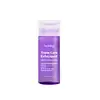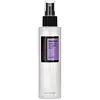What's inside
What's inside
 Key Ingredients
Key Ingredients

 Benefits
Benefits

 Concerns
Concerns

 Ingredients Side-by-side
Ingredients Side-by-side

Water
Skin ConditioningGlycerin
HumectantLactic Acid
BufferingEthoxydiglycol
HumectantGlycolic Acid
BufferingPEG-40 Hydrogenated Castor Oil
EmulsifyingSalicylic Acid
MaskingCentella Asiatica Extract
CleansingTriethanolamine
BufferingHydroxyethylcellulose
Emulsion StabilisingSodium Magnesium Silicate
Citric Acid
BufferingGluconolactone
Skin ConditioningDimethicone
Emollient1,2-Hexanediol
Skin ConditioningButylene Glycol
HumectantSodium Hydroxide
BufferingPotassium Azeloyl Diglycinate
Skin ConditioningCaprylyl Glycol
EmollientPolyglutamic Acid
Skin ConditioningEthylhexyl Cocoate
EmollientXanthan Gum
EmulsifyingDimethiconol
EmollientSodium Acetylated Hyaluronate
HumectantSodium Hyaluronate
HumectantHydrolyzed Sodium Hyaluronate
Skin ConditioningCapryloyl Salicylic Acid
ExfoliatingHyaluronic Acid
HumectantHydrolyzed Hyaluronic Acid
HumectantHydroxypropyltrimonium Hyaluronate
PEG-9 Diglycidyl Ether/Sodium Hyaluronate Crosspolymer
Skin ConditioningPotassium Hyaluronate
Skin ConditioningPentylene Glycol
Skin ConditioningPEG-60 Hydrogenated Castor Oil
EmulsifyingGlycine Soja Oil
EmollientTocopherol
AntioxidantEthylhexylglycerin
Skin ConditioningGlyceryl Caprylate
EmollientLactobacillus/Pear Juice Ferment Filtrate
Skin ConditioningPotassium Chloride
Sodium Hyaluronate Crosspolymer
HumectantRetinol
Skin ConditioningO-Cymen-5-Ol
AntimicrobialDimethylmethoxy Chromanol
AntioxidantPhellodendron Amurense Bark Extract
Skin ConditioningChlorphenesin
AntimicrobialSalix Alba Bark Extract
AstringentPhenoxyethanol
PreservativeRehmannia Chinensis Root Extract
Skin ConditioningMelia Azadirachta Leaf Extract
Skin ConditioningScutellaria Baicalensis Root Extract
AstringentHouttuynia Cordata Extract
Skin ConditioningGlycine Soja Seed Extract
Skin ConditioningWater, Glycerin, Lactic Acid, Ethoxydiglycol, Glycolic Acid, PEG-40 Hydrogenated Castor Oil, Salicylic Acid, Centella Asiatica Extract, Triethanolamine, Hydroxyethylcellulose, Sodium Magnesium Silicate, Citric Acid, Gluconolactone, Dimethicone, 1,2-Hexanediol, Butylene Glycol, Sodium Hydroxide, Potassium Azeloyl Diglycinate, Caprylyl Glycol, Polyglutamic Acid, Ethylhexyl Cocoate, Xanthan Gum, Dimethiconol, Sodium Acetylated Hyaluronate, Sodium Hyaluronate, Hydrolyzed Sodium Hyaluronate, Capryloyl Salicylic Acid, Hyaluronic Acid, Hydrolyzed Hyaluronic Acid, Hydroxypropyltrimonium Hyaluronate, PEG-9 Diglycidyl Ether/Sodium Hyaluronate Crosspolymer, Potassium Hyaluronate, Pentylene Glycol, PEG-60 Hydrogenated Castor Oil, Glycine Soja Oil, Tocopherol, Ethylhexylglycerin, Glyceryl Caprylate, Lactobacillus/Pear Juice Ferment Filtrate, Potassium Chloride, Sodium Hyaluronate Crosspolymer, Retinol, O-Cymen-5-Ol, Dimethylmethoxy Chromanol, Phellodendron Amurense Bark Extract, Chlorphenesin, Salix Alba Bark Extract, Phenoxyethanol, Rehmannia Chinensis Root Extract, Melia Azadirachta Leaf Extract, Scutellaria Baicalensis Root Extract, Houttuynia Cordata Extract, Glycine Soja Seed Extract
 Reviews
Reviews

Ingredients Explained
These ingredients are found in both products.
Ingredients higher up in an ingredient list are typically present in a larger amount.
1,2-Hexanediol is a synthetic liquid and another multi-functional powerhouse.
It is a:
- Humectant, drawing moisture into the skin
- Emollient, helping to soften skin
- Solvent, dispersing and stabilizing formulas
- Preservative booster, enhancing the antimicrobial activity of other preservatives
Butylene Glycol (or BG) is used within cosmetic products for a few different reasons:
Overall, Butylene Glycol is a safe and well-rounded ingredient that works well with other ingredients.
Though this ingredient works well with most skin types, some people with sensitive skin may experience a reaction such as allergic rashes, closed comedones, or itchiness.
Learn more about Butylene GlycolGlycolic Acid is arguably the most famous alpha hydroxy acid (AHA) with tons of research backing its benefits.
It is found naturally in sugar cane but the form used in skincare is usually synthetic for purity and stability.
Glycolic acid removes the top layer of dead skin cells to allow newer and fresher ones to emerge.
AHAs work by breaking down the structural “glue” that holds old skin cells in place. When that buildup is gone, your skin can renew itself more efficiently.
Research also shows glycolic acid stimulates collagen production, helping to firm and thicken the skin over time. This is one of its biggest advantages over other AHAs.
Overall, glycolic acid helps with:
Fun fact: Glycolic acid boosts skin hydration by helping it produce molecules that increase hyaluronic acid naturally.
To work best, glycolic acid products should have a pH between 3-4 (that’s where exfoliation is most effective but still gentle on skin).
The pH and concentration of a product are key to its effectiveness:
It is normal to feel a slight stinging sensation when using glycolic acid. This usually fades as your skin adjusts.
Because glycolic acid has the smallest molecular size in the AHA family, it can penetrate deeper, which enhances its effectiveness but also makes it more likely to irritate sensitive skin.
If your skin is very sensitive or prone to rosacea, glycolic acid may be too strong; in that case, try milder options like lactic acid or a PHA instead.
Recent studies suggest glycolic acid might even help protect against UV damage. But don’t skip sunscreen! Freshly exfoliated skin is more sensitive to the sun.
Glycolic acid is a skincare superstar. It smooths, brightens, hydrates, and firms the skin. Unless you’re highly sensitive, it’s well worth adding to your routine.
Read more about some other popular AHA's here:
Learn more about Glycolic AcidWater. It's the most common cosmetic ingredient of all. You'll usually see it at the top of ingredient lists, meaning that it makes up the largest part of the product.
So why is it so popular? Water most often acts as a solvent - this means that it helps dissolve other ingredients into the formulation.
You'll also recognize water as that liquid we all need to stay alive. If you see this, drink a glass of water. Stay hydrated!
Learn more about Water